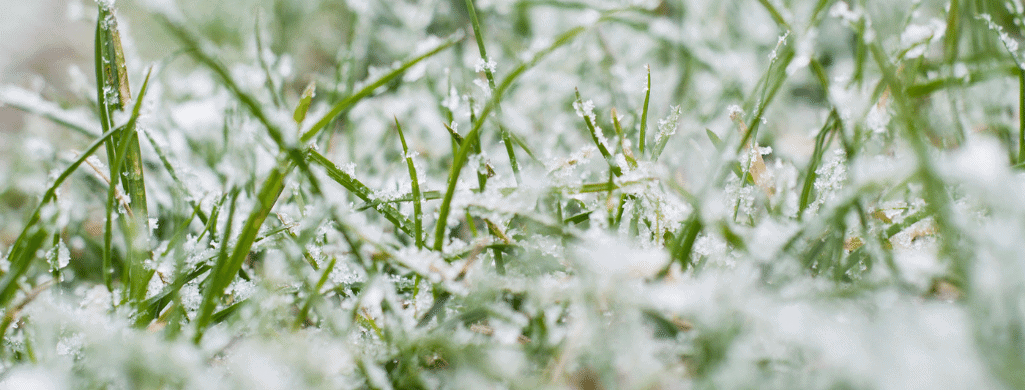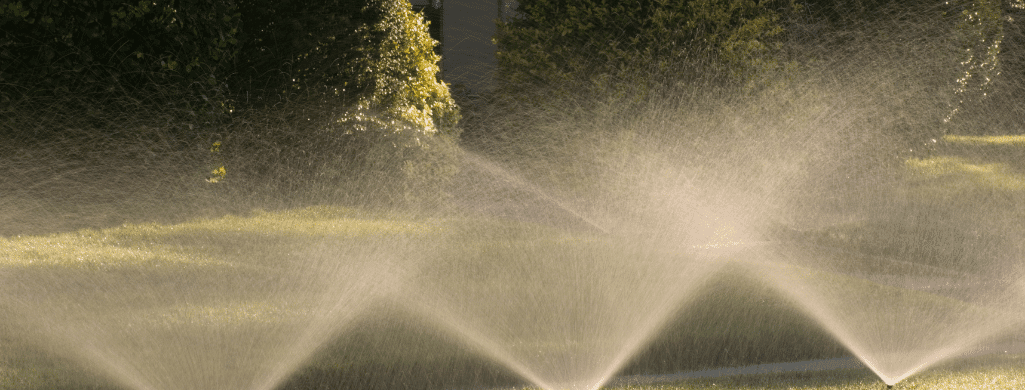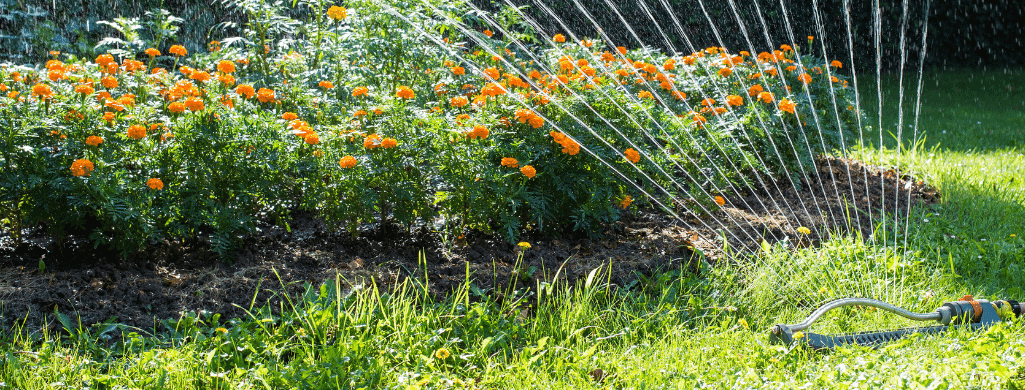One aspect of maintaining a healthy lawn is ensuring your grass receives plenty of water.
Heavy spring rains will give your grass a headstart in the growing season, and as the warmer months approach, you may rely on sprinklers to irrigate your lawn.
Summer watering is especially important for protecting your grass against drought.
Soil moisture evaporates quickly in the heat of summer, causing damage to lawn grasses.
But how do you keep your lawn healthy during dry periods in the colder months?
How cold is too cold to water your grass?
It is safe to continue watering your lawn in colder weather if daytime temperatures are consistently above 40° degrees Fahrenheit (4° C). Never water your lawn when the grass is covered in a layer of frost or when temperatures are below freezing.
Once ground temperatures are low enough for your grass to go dormant, you may reduce your regular watering schedule to once every 2-3 weeks.
Dormant grass only needs about ½” an inch of water per week, and it will naturally receive this amount from rain or snow.
Keep reading to learn more about watering your grass during the cold winter months.

Table of Contents
Are There Benefits to Watering Grass in Cold Weather?
Many people assume they do not need to water their lawns in the winter.
However, there are several benefits to watering your lawn during cold temperatures.
Soil moisture keeps grass roots hydrated and prevents them from going dormant.
Moist soil retains more heat than dry soil, effectively insulating against colder temperatures.
The added moisture will also strengthen the grass blades, allowing them to withstand damage from frost and cold weather.
Watering your grass within 24 hours of a freeze warning will offer your entire lawn some protection against damage.
Another benefit of watering your lawn in the winter is that you do not have to use much water.
During the warmer summer months, your lawn may need 1-2” inches of water every week to keep your grass healthy.
In the winter months, your grass only needs about ½” an inch of water every week, which will absorb most or all of this amount from groundwater.
Most grass types go dormant in the winter but need moisture to stay healthy.
Winter watering while your grass is in dormancy keeps the roots strong.
This strong root system allows the grass to experience robust growth during warmer weather in the spring.
When To Water Your Grass in the Winter
The best time to water your lawn is typically during the morning hours.
Watering the grass in the morning allows the soil to absorb moisture before evaporating in the afternoon sun.
If average temperatures during the day are close to 40° degrees Fahrenheit (4° C), it is better to water your lawn in the afternoon.
Waiting until later in the day increases soil temperatures for better moisture absorption.
Avoid watering your lawn at night, no matter what time of year.
Watering grass at night prevents the moisture from evaporating properly.
This excess water, along with colder nighttime temperatures, leads to an increase in fungal growth.
Cold freezing temperatures will kill some types of fungal growth on the surface, but the fungus may also infect the soil and spread to your entire lawn.
Pink and gray snow mold are the most common types of lawn fungus in the cold months, and damage to your lawn may not be apparent until the spring.
Further Reading: Should you cut grass in winter?

When To Stop Using Your Sprinklers
When temperatures are below 40° degrees Fahrenheit (9° C), and it is too cold to water your lawn, it is also time to turn off your sprinklers.
Using your sprinklers in near-freezing or freezing temperatures will damage the entire system.
Any water in your sprinkler heads or hoses will expand as it freezes.
The frozen water will cause the hoses and any other plastic parts in your sprinkler system to crack.
When you stop using your sprinklers in the winter, it is best to winterize your system to prevent any damage during chilly weather.
You may hire a professional to winterize your sprinkler system or do it yourself.
The following steps outline the entire process but consult your sprinkler’s user manual if you are unsure of what to do.
Turn Off the Water
The first step in winterizing your sprinkler system is to shut off the water going to it.
There is usually a main shut-off valve found near your water meter.
You also need to turn off any backflow valves.
Typically, two valves are found near the backflow device, so be sure to turn both of them off.
Not all sprinkler systems have a backflow preventer, so check the owner’s manual if you are unsure.
Turn Off the Automatic Timer
Next, you must turn off the automatic timer if your sprinkler system is equipped with one.
If you are worried about losing your settings or other information, check to see if your system has a “rain mode.”
The rain mode on an automatic timer allows the system to power down while retaining all of its programmable settings.
When the weather is warmer in the spring, and it is time to use your sprinklers again, simply turn the rain mode off, and everything should resume working again.
Drain the Water
Draining the water from your sprinkler system is one of the most critical but time-consuming steps in winterizing.
It is crucial to ensure no water is left in the system to freeze and cause damage.
There are three common methods of draining a sprinkler system.
Some systems have valves at the low points or ends of the pipes to allow you to drain the water manually.
Since the system is under pressure, turn the valves very slowly to let the water drain from the pipes.
When all of the water has been drained from the pipes, close the valves.
More sophisticated sprinkler systems have a feature allowing them to automatically drain when the main water supply is shut off and the pressure drops.
This automatic draining system is typically activated by running one of the sprinkler heads with the main water valve shut off.
The final method for draining your sprinkler system involves attaching an air compressor to one of the pipes to force the water out of the sprinkler heads.
You will need an air compressor capable of producing at least 50 psi.
Using an air compressor to blow out the water in your sprinkler system is not recommended for inexperienced homeowners.
Some systems may be unable to handle the air pressure, and you may cause damage by using this method.
It is best to hire a professional if this is the only method available to drain your sprinkler system.
Insulate Exposed Components
Finally, you must insulate any exposed components of your sprinkler system to protect them from freezing temperatures.
These components include the main shut-off valve and any exposed pipes or backflow preventers.
Use foam covers or insulation tape to wrap the exposed sprinkler system components.
Do not block air vents or drain outlets on the backflow preventers.

Will Frost Kill Your Grass?
A light frost is not likely to kill grass on a mature lawn, although it may cause severe damage to new sod or grass sprouts.
However, heavy frost will easily damage the cells of grass blades and roots, causing your lawn to die.
Watering your lawn when it is covered in a layer of frost also can cause severe damage or death to the grass.
Avoid walking on frost-covered grass whenever possible as well.
The frozen blades of grass will be very brittle and easily damaged by foot traffic.
Air and soil temperatures do not have to be below freezing for frost formation on your grass.
Temperatures as low as 36° degrees Fahrenheit (2° C) will cause water droplets or morning dew on your grass to form frost.
Watering your lawn while temperatures are still above 40° degrees Fahrenheit (9° C) will protect your grass from frost.
The moisture in the soil will retain enough heat to prevent the grass-level air temperatures from freezing.
Warm soil also helps to protect the grass roots from frost damage and prevent them from going dormant.
Further Reading: Can grass seed grow when it’s cold?
Is It Safe To Water Grass After It Freezes?
It is crucial to avoid watering your grass when temperatures are consistently lower than 40° degrees Fahrenheit (9° C).
In the early stages of winter, there may be cold snaps where the weather is below the freezing mark for only one night, followed by considerably warmer temperatures.
As long as the next few days in the weather forecast are predicted to be 40° degrees Fahrenheit (9° C) or above, it is safe to water your grass.
Always be mindful of weather reports to monitor upcoming changes for the possibility of frost.
Take care not to water your lawn too much at once in case temperatures unexpectedly drop below freezing.
During late fall and early winter, soil temperatures may be up to 10° degrees warmer than air temperatures.
Once there is a hard freeze, it is more difficult for ground temperatures to recover during the day.
From late winter until spring, soil temperatures shift to become 10° degrees cooler than ambient air temperatures.
Do not water your grass when the ground is frozen, as the soil will not be able to absorb moisture.
The excess water will sit on top of the soil, where it may freeze and cause damage to the grass.
When temperatures are consistently below freezing in the chilly winter months, it is best not to water your lawn again until warmer temperatures return in spring.